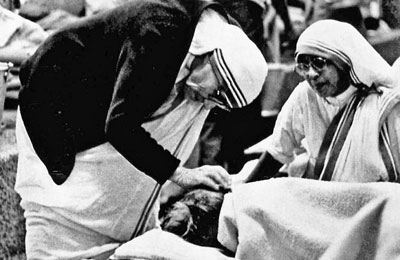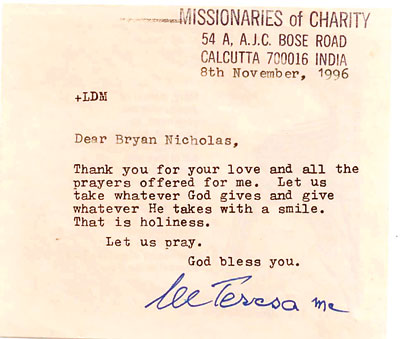She lived the truism that a little kindness can go a long way
Known as “The Living Saint” during her lifetime, Mother Teresa will be formally Canonised by Pope Francis today, thus placing her among the multitude of Saints of the Catholic Church.

Mother Teresa attends to a patient in her home for the dying in Kolkata’s teeming slums. File pic, REUTERS
The year was 1910, the day August 26, in a little town in Skopje, (the current capital of the Republic of Macedonia), a girl who was named Agnes Guxha Bojaxhiu was born to Albanian parents. She was later to become known as - ‘The Angel of Mercy” - “India’s Angel of the slums” - “Saint of the Gutters”.
At the age of 18 she submitted to the call of God and entered Loretto Convent in Dublin, Ireland. She took her first profession in 1931 and was to be known as Sister Teresa, after her patroness, St. Therese of Lisieux.
As the majority of the Loretto Nuns in Ireland served in India, she too got a teaching assignment in Loretto Convent, Kolkata, and having taken her final profession on May 24, 1937 she was to be known as Mother Teresa, following Loretto custom.
It was on September 10, 1946, on a train journey from Kolkata to Darjeeling that Mother Teresa received the “call within a call” which was to give rise to the Order of the Missionaries of Charity. After two years of serving on the streets of Kolkata, Mother Teresa requested and received Vatican permission to start a diocesan congregation which would officially be erected as a religious institute on October 7, 1950.
She was a living model of humility and love. When I met this ‘Mother of Mercy’ on the two occasions she visited Sri Lanka - first in 1984 to inaugurate a Home for the Destitute in the city of Colombo, the few words exchanged with this wrinkled-faced individual known as the ‘Angel of the Slums’ inspired and awed me. Her self- determination, her trust in the unfailing providence of God for her work was evident.
Awards and publicity meant nothing to her as her parting words to me on one such meeting was - “we don’t work for glory or for money, we work for God.”
Her work knew no caste, creed, religion, politics or language. It was a complete surrender and dedication to the sole cause of caring for the unwanted, unloved and uncared for in society - the poorest of the poor, as could be witnessed from some little known and unpublicised incidents in her life.
In 1982, Mother Teresa persuaded Israelis and Palestinians who were in the midst of a skirmish, to a ceasefire long enough to rescue 37 mentally handicapped patients from a besieged hospital in Beirut.When the walls of Eastern Europe collapsed, she expanded her efforts to communist countries that had rejected her, embarking on dozens of projects. Mother Teresa also travelled to help the hungry in Ethiopia, radiation victims at Chernobyl, and earthquake victims in Armenia. In 1991, Mother Teresa returned for the first time to her native region and opened a Missionaries of Charity Brothers home in Tirana, Albania.
During her lifetime and even after her death, Mother Teresa was consistently listed by Gallup’s List of Widely Admired People to be the single most widely admired person. In 1999, she was ranked as the “most admired person of the 20th century.” Notably, Mother Teresa outpolled all others by a wide margin, and was in first place in all major demographic categories except the very young.
Honour after honour who showered upon her for her humanitarian services and among the 124 Awards she received was the “Padma Shri” (Lord of the Lotus) conferred in 1962 by the Indian Government, for her commitment to the poor of the slums in Kolkata. This was the first instance this award was given to a non-Indian national.

Precious souvenir: A letter from Mother Teresa to the writer
That same year she was awarded the “Ramon Magsaysay Award” for Peace & International Understanding. In 1969 the Indian Government bestowed on her the “Jawarhalal Nehru Award” for ‘Dedicated Service to Humanity’ and in January 1971 Pope Paul VI awarded her the first “International Pope John XXIII Peace Prize.”
It was in 1979 that Mother Teresa became a household name throughout the world when she was awarded the “Nobel Peace Prize” for her respect for the individual human being, for his or her dignity and innate value. However, she sent word to the organisers that her acceptance of the prize was on the condition that every cent would be spent on the poorest of the poor. She refused the conventional ceremonial banquet given to laureates, and asked that the cost be diverted to the poor in Kolkata.
She raised eyebrows at the awards ceremony held at the Oslo City Hall on December 10, 1979 when she started her acceptance speech with the words - “let us pray the prayer of Saint Francis of Assisi”. She had made sure that a copy of the prayer was placed on the seat of all those present. In fact, her Sisters say this prayer every morning before breakfast.
On receiving the Nobel Peace Prize Mother Teresa was asked - “what can we do to promote world peace?” Her answer was simple: “Go home and love your family”.
The very next year, in 1980, she was awarded the highest Indian Award - ‘The Bharat Ratna’ and in 1982 conferred with the “Companion of the Order of Australia” which is the highest general award of Australia. In 1983 Queen Elizabeth II invested her with the highest British Award, the prestigious “Order of Merit”.
The Presidential Medal of Freedom, awarded by the US President for especially meritorious contribution to world peace was made to Mother Teresa in 1985 by President Ronald Reagan.
Pope John Paul II put Mother Teresa on the fast track for sainthood when he allowed the beatification examination process to begin less than two years after her death in 1997. Very aptly, on October 19, 2003, she was beatified after the Vatican recognized the healing miracle of an Indian woman’s prayers to Mother Teresa, which caused the tumor in her abdomen to disappear. This date happened to be Mission Sunday when Catholics all over the world pray for the missions and the missionaries.
Her Canonisation in Rome today has a special universal significance as it comes at the conclusion of the special Jubilee Year of Mercy, the date previously established by the Vatican, commemorating workers and volunteers engaged in works of mercy. What better way to honour an individual who has been referred to during her lifetime as the “Angel of Mercy”. It also comes on the eve of her 19th death anniversary.
Every human being suffers and understands suffering. Every human being also understands kindness and compassion. Mother Teresa is important because she lived her life in such a way as to inspire kindness. She would very often say -
“If you judge people, you have no time to love them.”
“There are no great things, only small things with great love.”
“If you can’t feed a hundred people, then feed just one.”
“At the end of life we will not be judged by how many diplomas we have received,
how much money we have made, how many great things we have done.
We will be judged by the words of Christ – “I was hungry, and you gave me to eat,
I was naked and you clothed me. I was homeless, and you took me in.”
Saint Teresa of Kolkata, pray for us that we may endeavour to live a life submitting to the needs of our brothers and sisters, especially those most unloved and unwanted – the poorest of the poor.


